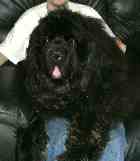Canine Hip Dysplasia
Canine hip dysplasia is a malformation of the hip joint, where the leg does not fit properly into the hip bone. The condition is usually hereditary, so it is essential that both parents of your puppy have low hip score certificates.
Although the condition is usually hereditary, there is a chance of it developing by too much exercise being allowed whilst the puppy is growing. It is essential to realise and provide the proper puppy care for this breed.
Symptoms include lameness, stiffness on getting up, sensitivity to touch and sometimes a marked change in behaviour. The dog will have great difficulty even climbing a small step.
The condition can only be diagnosed by x-rays and can be alleviated by supplements and anti-inflammatory medications, although sometimes this is not enough and surgery is required.
Surgery will involve the replacement of the hip joint, much as is done in humans. The procedure has had a great deal of success in dogs, but it is extremely expensive. Lifetime Insurance will cover this under normal circumstances. The recovery period is difficult in a dog, especially a young dog, and they will need to be kept fairly immobile whilst this is being achieved.
If left untreated the condition is crippling and can lead to severe canine arthritis.
Any indication of discomfort or pain should be investigated at the earliest opportunity.
All large dog breeds are susceptible to this condition and some have a much higher incidence of the condition than other breeds. A good breeder will never breed from a dog with a high hipscore. The average hipscore for a Newfoundland dog is 25, but a good hipscore will be far below that.



